Bra
A bra, short for brassiere or brassière (US: /brəˈzɪər/, UK: /ˈbræsɪər/ or /ˈbræzɪər/; French: [bʁasjɛʁ]), is a form-fitting undergarment designed to support or cover the wearer's breasts. Bras are designed for a variety of purposes, including enhancing a woman's breast size, creating cleavage, or for other aesthetic or practical considerations. Swimsuits, camisoles, and backless dresses may have built-in breast support with supportive bra cups. Nursing bras are designed to facilitate breastfeeding. Some women have a medical and surgical need for brassieres, but most women wear them for fashion or cultural reasons. There is no evidence that bras prevent breasts from sagging and one study even suggests the opposite (weakening of the breasts supportive tissue)[1], with the exception of wearing them during sports exercices.
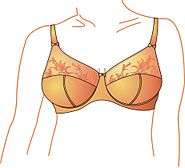
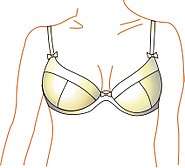
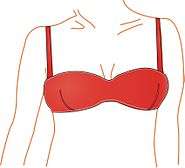
Bras have gained importance beyond their mere functionality as a garment. Women's choices about what kind of bra to wear are consciously and unconsciously affected by social perceptions of the ideal female body shape, which changes over time. Bras have become a fashion item and cultural statement that are sometimes purposefully revealed by the wearer or even worn as outerwear.
Bras are complex garments made of many parts. Manufacturing standards assume idealized, standard breast shapes and sizes that don't match most women's bodies. Companies use vanity sizes, influencing women to purchase sizes that give the impression they are slimmer or more buxom. In addition, international manufacturing standards and measurement methods vary widely. Due to these challenges, women have a hard time finding a correctly fitting bra. When they do find one that appears to fit, their tendency is continuing wearing the same bra size despite weight gain or loss. All of these factors result in up to 85 percent of those women who wear bras choosing and wearing the wrong size.[2][3] Due to the difficulty in finding a correctly fitting bra, a majority of women commonly experience discomfort while wearing a bra.
Some women have protested societal expectations and sometimes school and workplace dress codes that require women to wear support garments. As early as 1873, the author Elizabeth Stuart Phelps advocated that women burn their corsets. This was echoed in 1968 at the protest during the Miss America pageant when women symbolically threw a number of feminine products into a large trash can. A reporter conflated their protest with Vietnam-era men who burned their draft cards, creating the trope of bra-burning feminists.
Etymology
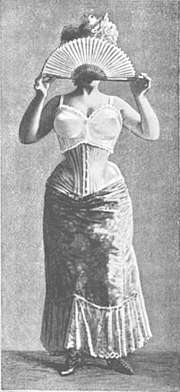
The term brassiere, from French brassière, was used by the Evening Herald in Syracuse, New York, in 1893.[4] It gained wider acceptance in 1904 when the DeBevoise Company used it in their advertising copy—although the word is actually French for a child's undershirt. In French, it is called a soutien-gorge (literally, "throat-supporter").[5] It and other early versions resembled a camisole stiffened with boning.[6]
Vogue magazine first used the term brassiere in 1907,[7][8] and by 1911 the word had made its way into the Oxford English Dictionary.[9] On 3 November 1914, the newly formed US patent category for "brassieres" was inaugurated with the first patent issued to Mary Phelps Jacob.[10][11] In the 1930s, brassiere/brassière was gradually shortened to bra.[5]
History
Wearing a garment to support the breasts may date back to ancient Greece.[12] Women wore an apodesmos,[13] later stēthodesmē,[14] mastodesmos[15] and mastodeton,[16] all meaning "breast-band", a band of wool or linen that was wrapped across the breasts and tied or pinned at the back.[17][18] Roman women wore breast-bands during sport, such as those shown on the Coronation of the Winner mosaic (also known as the "Bikini mosaic").

Fragments of linen textiles found at Lengberg Castle in East Tyrol in Austria dated to between 1440 and 1485 are believed to have been bras. Two of them had cups made from two pieces of linen sewn with fabric that extended to the bottom of the torso with a row of six eyelets for fastening with a lace or string. One had two shoulder straps and was decorated with lace in the cleavage.[19][20]
From the 16th century, the undergarments of wealthier women in the Western world were dominated by the corset, which pushed the breasts upwards. In the later 19th century, clothing designers began experimenting with alternatives, splitting the corset into multiple parts: a girdle-like restraining device for the lower torso, and devices that suspended the breasts from the shoulder to the upper torso.[12]
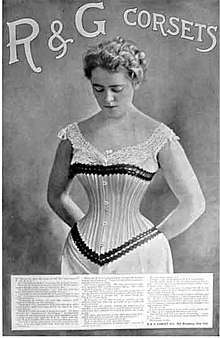
Women have played a large part in the design and manufacture of the bra, accounting for half the patents filed.[21] The Dresden-based German, Christine Hardt, patented the first modern brassiere in 1899.[22] Sigmund Lindauer from Stuttgart-Bad Cannstatt, Germany, developed a brassiere for mass production and patented it in 1912. It was mass-produced by Mechanische Trikotweberei Ludwig Maier und Cie. in Böblingen, Germany.[23][24] In the United States, Mary Phelps Jacob received a patent in 1914 for the first brassiere design that is recognized as the basis for modern bras.[25][26] Mass production in the early 20th century made the garment widely available to women in the United States, England, Western Europe, and other countries influenced by western fashion.[5] Metal shortages in World War I encouraged the end of the corset.
Brassieres were initially manufactured by small production companies and supplied to retailers. The term "cup" was not used until 1916, and manufacturers relied on stretchable cups to accommodate different sized breasts.[27] Women with larger or sagging breasts had the choice of long-line bras, built-up backs, wedge-shaped inserts between the cups, wider straps, Lastex, firm bands under the cup, and light boning.[27]
In October 1932, the S.H. Camp and Company correlated the size and pendulousness of breasts to letters A through D.[6] Camp's advertising featured letter-labeled profiles of breasts in the February 1933 issue of Corset and Underwear Review. In 1937, Warner began to feature cup sizing in its products.[28] Adjustable bands were introduced using multiple hook and eye closures in the 1930s.[29] By the time World War II ended, most fashion-conscious women in Europe and North America were wearing brassieres, and women in Asia, Africa, and Latin America began to adopt it.[5]
An urban legend that the brassiere was invented by a man named Otto Titzling ("tit sling") who lost a lawsuit with Phillip de Brassiere ("fill up the brassiere") originated with the 1971 book Bust-Up: The Uplifting Tale of Otto Titzling and the Development of the Bra and was propagated in a comedic song from the movie Beaches.[30]
Manufacture
Construction
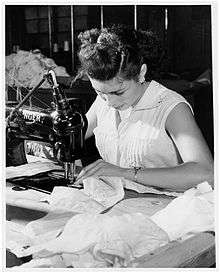
Mass-produced bras are manufactured to fit a prototypical woman standing with both arms at her sides. The design assumes that both breasts are equally sized and symmetrical.[31] Manufacturing a well-fitting bra is a challenge since the garment is supposed to be form-fitting but women's breasts may sag, vary in volume, width, height, shape, and position on the chest.[31][32][33] Manufacturers make standard bra sizes that provide a "close" fit, however even a woman with accurate measurements can have a difficult time finding a correctly fitted bra because of the variations in sizes between different manufacturers. Some manufacturers create "vanity sizes" and deliberately mis-state the size of their bras in an attempt to persuade women that they are slimmer and more buxom.[34][35]
A bra is one of the most complicated garments to make. A typical design has between 20 and 48 parts, including the band, gore, side panel, cup, apex, neckline, underwire, strap, ring, slider, strap join, and closure. Bras are built on a square frame model. Lingerie designer Chantal Thomass said,
It's a highly technical garment, made of lots of tiny pieces of fabric, with so many sizes to consider for the different cups, etc. It's a garment you wash every day, so the seams and structure need to be extremely robust. It's very different from a piece of clothing; it's in direct contact with the skin, it needs to be super solid.[36]
The primary component offering the most support is a chest band that wraps around the torso. It supports two cups that are usually held in place by two shoulder straps. The chest band is usually closed in the back by a hook and eye fastener, but smaller busted models may be fastened at the front.[37] Sleep bras or athletic bras do not have fasteners and are pulled on over the head and breasts. The section between the cups is called a gore. The section under the armpit where the band joins the cups is called the "back wing".[38]
Bra components, including the cup top and bottom (if seamed), the central, side and back panels, and straps, are cut to manufacturer's specifications. Many layers of fabric may be cut at the same time using computer-controlled lasers or bandsaw shearing devices. The pieces are assembled by piece workers using industrial sewing machines or automated machines. Coated metal hooks and eyes are sewn in by machine and heat processed or ironed into the back ends of the band and a tag or label is attached or printed onto the bra itself.[38] The completed bras are folded (mechanically or manually), and packaged for shipment.[39]
The chest band and cups, not the shoulder straps, are designed to support the weight of women's breasts. Strapless bras rely on an underwire and additional seaming and stiffening panels to support them. The shoulder straps of some sports bras cross over at the back to take the pressure off the shoulders when arms are raised. Manufacturers continually experiment with proprietary frame designs. For example, the Playtex "18-Hour Bra" model utilizes an M-Frame design.[38]
Materials
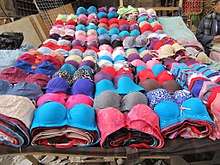
Bras were originally made of linen, cotton broadcloth, and twill weaves and sewn using flat-felled or bias-tape seams. They are now made of a variety of materials, including Tricot, Spandex, Spanette, Latex, microfiber, satin, Jacquard, foam, mesh, and lace,[38] which are blended to achieve specific purposes. Spandex, a synthetic fiber with built-in "stretch memory", can be blended with cotton, polyester, or nylon. Mesh is a high-tech synthetic composed of ultra-fine filaments that are tightly knit for smoothness.[38]
Sixty to seventy per cent of bras sold in the UK and US have underwired cups. The underwire is made of metal, plastic, or resin.[40][41] said the antecedents for underwire in bras date to at least 1893, when Marie Tucek of New York City patented a breast supporter, a sort of early push-up bra made of either metal or cardboard and then covered with fabric.[42] Underwire is built around the perimeter of the cup where it attaches to the band, increasing its rigidity to improve support, lift, and separation.[37]
Wirefree or softcup bras have additional seaming and internal reinforcement.
By the late 1970s, wire-free bras were emerging both at Hanky Panky and at Hanro in Switzerland. Cosabella in Italy and Eres (company) in France followed in the 1980s, as did Eberjey in the 1990s. "These five companies set the pace for contemporary bralettes," | Quote = Ellen Lewis The Lingerie Briefs editor |. Their designs were seen as casual feminist alternatives to the more constrictive undergarments that preceded them. Many women slept in their bralettes. |Work = The New York Time| URL = https://www.nytimes.com/2019/07/31/fashion/bralettes-bras-no-underwire.html | date = 2019 July 31 | T-shirt bras utilize molded cups that eliminate seams and hide nipples . Others use padding or shaping materials to enhance bust size or cleavage.[43]
Size and fitting
In most countries, bras come in a band and cup size, such as 34C; 34 is the chest band, or the measurement around the torso directly underneath the breasts, and C is the cup size, which refers to the volume of the breasts. Most bras are offered in 36 sizes; the Triumph "Doreen" comes in 67 sizes, up to 46J.[2]
The cup size varies depending on the band size. A D cup on a 38 band is larger in volume than a D cup on a 34 band, as the volume of a woman's breast increases as her chest band dimension increases.[44] In countries that have adopted the European EN 13402 dress-size standard, the measurement is rounded to the nearest multiple of 5 centimetres (2.0 in).[45][46]
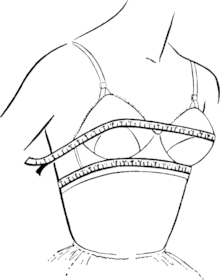
International manufacturing standards and measurement systems vary widely. Bras are designed for an ideal body, but women's anatomy vary widely. Ten percent of women's breasts are asymmetrical, with the left breast being larger in 62 percent of cases.[47] One woman's breasts may be ptotic and widely spaced, another's might be centered closely on the chest, upright, and very full. As a result, finding a correctly fitting bra is extremely difficult. When women find a bra that appears to fit, they tend to stay with that size, even though they may lose and gain weight.[21][35][48][49]
In a survey in the United Kingdom, 60 per cent of over 2,000 women between the ages of 16 to 75 said they had had a bra fitting, and 99 per cent said that fit was the least important factor when selecting a bra.[50] Increased publicity about the issue of poorly fitted bras has increased the number of women seeking a fitting. The UK retailer Marks & Spencer stated that about 8,000 women are fitted for bras in their stores weekly.[51] Despite this, about 80–85 percent of women still wear the wrong bra size.[52][53]
Bra experts recommend professional bra fittings from the lingerie department of a clothing store or a specialty lingerie store, especially for cup sizes D or larger, and particularly if there has been significant weight gain or loss, or if the wearer is continually adjusting her bra.[2] Women in the UK change their bra size on average six times over their lifetimes.[54]
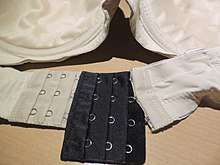
Signs of a loose bra band include the band riding up the back. If the band causes flesh to spill over the edges, it is too small.[55] A woman can test whether a bra band is too tight or loose by reversing the bra on her torso so that the cups are in the back and then check for fit and comfort.[56] Experts suggest that women choose a band size that fits using the outermost set of hooks. This allows the wearer to use the tighter hooks as the bra stretches during its lifetime.[57]
Styles
Bras may be designed to enhance a woman's breast size, or to create cleavage, or for other aesthetic, fashion, or more practical considerations. Nursing bras are designed to aid breastfeeding.[12] Compression bras, such as sports bras, push against and minimize breast movement, whereas encapsulation bras have cups for support.[58] Breast support may be built into some swimsuits, camisoles and dresses.[59][60]
Bras come in a variety of styles, including backless, balconette, convertible, shelf, full cup, full coverage bra, demi-cup, minimizing, padded, plunge, lounge bra, posture, push-up, racerback, sheer, strapless, T-shirt, underwire, unlined, and soft cup.[61] Some special styles are manufactured by companies like plus-size bra, bridal bra and cancer bra. Cancer bra is a special in its kind for breast cancer patient whose breast removed in the operation. The styles helps them to look natural after operation.
Culture
Fashion
Women's choices about what bra to wear are consciously and unconsciously affected by social perceptions of the ideal female body shape, which changes over time.[62] As lingerie, women wear bras for sex appeal. Bras can also be used to make a social statement as evidenced by Jean-Paul Gaultier's designs and the cone-shaped bra Madonna wore outside her clothing on her Blond Ambition World Tour.[63]
In the 1920s in the United States – the flapper era – the fashion was to flatten the breasts. During the 1940s and 1950s, the sweater girl became fashionable, supported by a bullet bra (known also as a torpedo or cone bra) as worn by Jane Russell and Patti Page.[64] In the early 1960s, smaller breasts gained popularity, and in the late 1990s larger breasts became more fashionable.[51] Iris Marion Young described preferences in the United States in 1990: "round, sitting high on the chest, large but not bulbous, with the look of firmness." This is regarded as contradictory in several ways.[65]
As outerwear, bras in the form of bikini tops in the 1950s became the acceptable public display in modern times.[63] During the 1960s, designers and manufacturers introduced padded and underwire bras. After the Miss America protest in September 1968, manufacturers were concerned that women would stop wearing bras. In response, many altered their marketing and claimed that wearing their bra was like "not wearing a bra".[66] In the 1970s women sought more comfortable and natural-looking bras.[64]
Victoria's Secret commissions a fantasy bra every autumn. In 2003 it hired the jeweller Mouawad to design one containing more than 2500 carats of diamonds and sapphires; valued at US$10 million, it was the world's most valuable bra at the time.[67]
Undergarment as outerwear
.jpg)
.jpg)
Sports bras were first invented in 1975. Women wore them under other clothing for the next 25 years.[68] But on 10 July 1999, Brandi Chastain scored the fifth kick in the penalty shootout to give the United States the win over China in the final game of the 1999 FIFA Women's World Cup Final. In celebration, she spontaneously whipped off her jersey, exposing her sports bra. Her act is regarded by some as a historical event that boosted wearing sports bras alone.[68][69] From that point forward, sports bras were increasingly worn as outerwear.[70]
Madonna was one of the first to start showing her bra straps, in the late 1980s.[71] A corset she wore as outerwear during her 1990 Blond Ambition World Tour sold for US$52,000 in 2012 at the Christie's Pop Culture auction in London.[72] Versace's autumn 2013 couture collection featured fashions that were open in the front, revealing underwire bras.[73] It became fashionable from the early 1990s to wear clothing that showed bra straps.[74][75][76][77]
Wearing clothes that reveal the bra or straps became so common that Cosmopolitan created guidelines in 2012 on how to expose them. Advice included avoiding plain, flesh-toned, smooth-cup bras, so that the exposure does not appear accidental; making sure the bra is in good condition; and wearing a style that either matches the colour of the outerwear or is dramatically different.[78]
Decreasing Western usage
While a few women have a medical and surgical need to wear a brassiere, informal surveys have found that many women began wearing bras to be fashionable, to conform to social or maternal pressure, or for physical support. Very few cited comfort as the reason. In fact, many women experience so much discomfort that they remove their bra as soon as they can. Many Western women recognize that they have been socialized to wear bras, and some who choose to go without report feeling exposed or "subject to violation".[79][80][5]
In Western society, there is an increasing trend towards bralessness among a number of women, especially millennials, who have expressed opposition to and are giving up wearing bras.[81] Being seen in public while not wearing a bra is becoming more acceptable, encouraging more women to go without. In 2016, Allure magazine fashion director Rachael Wang wrote, "Going braless is as old as feminism but it seems to be bubbling to the surface more recently as a direct response to Third Wave moments like #freethenipple hashtag campaign, increased trans-visibility like Caitlyn Jenner's Vanity Fair cover ... and Lena Dunham’s show Girls (which features young girls often without bras)."[82]
_(cropped).jpg)
In an online survey for All You magazine in 2013, 25 percent of women reported that they do not wear a bra every day.[83] Surveys have reported that 5–25 per cent of Western women do not wear a bra.[67][84][85] A National No Bra Day was first observed in the United States on 9 July 2011.[86] Women posted on Twitter about the relief they felt when taking off their bra.[87] More than 250,000 people expressed an interest in "attending" the day on a Facebook page.[88] No Bra Day is now observed internationally on 13 October.[67]
A Harris Poll commissioned by Playtex asked more than 1,000 women what they like in a bra. Among the respondents, 67 per cent said they prefer wearing a bra to going braless, while 85 per cent wanted to wear a "shape-enhancing bra that feels like nothing at all." They were split as regards underwire bras: 49 per cent said they prefer underwire bras, the same percentage as those who said they prefer wireless bras.[43] According to underwire manufacturer S & S Industries of New York, who supply bras to Victoria's Secret, Bali, Warner's, Playtex, Vanity Fair, and other labels, about 70 per cent of bra-wearing women wear underwire bras.[89]
Third-world usage
Bras are not universally worn around the world; in some third-world countries bras may cost up to 10–30 hours of a woman's wages, making them unaffordable to most of the population.[90][91][92] As of 2011, women in Fiji needed to pay up to a week's wages for a new bra.[93] Bras are highly prized at second-hand markets in West Africa.[91][92] The Uplift Project provides recycled bras to women in developing countries.[94] Since 2005 they have shipped 330,000, including to Fiji, Vanuatu, Tonga, and Cambodia.[90]
In 2009 Somalia's hard-line Islamic group Al-Shabaab forced women to shake their breasts at gunpoint to see if they were wearing bras, which they called "un-Islamic".[95][96] A resident of Mogadishu whose daughters were whipped said, "The Islamists say a woman's chest should be firm naturally, or flat."[95]
Economic impact
Consumers spend around $16 billion a year worldwide on bras.[97] In the US during 2012, women owned an average of nine bras and wore six on a regular basis.[97] That increased from 2006, when the average American woman owned six, one of which was strapless, and one in a colour other than white.[98] British women in a 2009 survey reported that they owned an average of 16 bras.[51]
The average bra size among North American women has changed from 34B in 1983 to a 34DD in 2012–2013,[99] and from 36C in 2013 to 36DD in the UK during 2014–2015.[100] The change in bra size has been linked to growing obesity rates, breast implants, increased birth control usage, estrogen mimicking pollutants, the availability of a larger selection of bras, and women wearing better fitting bras.[99][101]
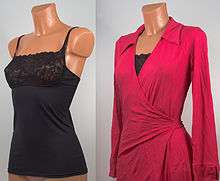
Bras are made in Asian countries, including Sri Lanka, India, and China. While there has been some social pressure from the anti-sweatshop and anti-globalization movements on manufacturers to reduce use of sweatshop labour, most major apparel manufacturers rely on them directly and indirectly. Prior to 2005, a trade agreement limited textile imports to the European Union and the US. China was exporting US$33.9 billion in textiles and clothing each year to the EU and the US. When those quotas expired on 1 January 2005, the so-called Bra Wars began. Within six months, China shipped 30 million more bras to the two markets: 33 per cent more to the US and 63 per cent more to the EU.[102] As of 2014, an average bra cost £29.80.[103] As of 2012, Africa imported US$107 million worth of bras, with South Africa accounting for 40 per cent. Morocco was second and Nigeria third, while Mauritius topped purchasing on a per capita basis.[104]
In countries where labour costs are low, bras that cost US$5–7 to manufacture sell for US$50 or more in American retail stores. As of 2006, female garment workers in Sri Lanka earned about US$2.20 per day.[102] Similarly, Honduran garment factory workers in 2003 were paid US$0.24 for each $50 Sean John sweatshirt they made, less than one-half of one per cent of the retail price.[105] In 2009, residents in the textile manufacturing city of Gurao in the Guangdong province of China made more than 200 million bras. Children were employed to assemble bras and were paid 0.30 yuan for every 100 bra straps they helped assemble. In one day they could earn 20 to 30 yuan.[106]
Western Feminist opinions
In 1968 at the feminist Miss America protest, protesters symbolically threw a number of feminine products into a "Freedom Trash Can". These included bras,[107] which were among items the protesters called "instruments of female torture"[108] and accouterments of what they perceived to be enforced femininity. A local news story in the Atlantic City Press erroneously reported that "the bras, girdles, falsies, curlers, and copies of popular women's magazines burned in the 'Freedom Trash Can'".[109][110] Individuals who were present said that no one burned a bra nor did anyone take off her bra.[108][111] However, a female reporter (Lindsy Van Gelder) covering the protest drew an analogy between the feminist protesters and Vietnam War protesters who burned their draft cards, and the parallel between protesters burning their draft cards and women burning their bras was encouraged by some organizers including Robin Morgan. "The media picked up on the bra part", Carol Hanisch said later. "I often say that if they had called us 'girdle burners,' every woman in America would have run to join us."[111][112]
Feminism and "bra-burning" became linked in popular culture.[113][114] The analogous term jockstrap-burning has since been coined as a reference to masculism.[115] While feminist women did not literally burn their bras, some stopped wearing them in protest.[116][117] The feminist author Bonnie J. Dow has suggested that the association between feminism and bra-burning was encouraged by individuals who opposed the feminist movement.[107] "Bra-burning" created an image that women weren't really seeking freedom from sexism, but were attempting to assert themselves as sexual beings.[118] This might lead individuals to believe, as Susan J. Douglas wrote, that the women were merely trying to be "trendy, and to attract men."[119][120][121][122] Some feminist activists believe that anti-feminists use the bra burning myth and the subject of going braless to trivialize what the protesters were trying to accomplish at the feminist 1968 Miss America protest and the feminist movement in general.[123][124][125]
The trope of feminists burning their bras was anticipated by an earlier generation of feminists who called for burning corsets as a step toward liberation. In 1873 Elizabeth Stuart Phelps Ward wrote:
So burn up the corsets! ... No, nor do you save the whalebones, you will never need whalebones again. Make a bonfire of the cruel steels that have lorded it over your thorax and abdomens for so many years and heave a sigh of relief, for your emancipation I assure you, from this moment has begun.[126]
Some feminists began arguing in the 1960s and 1970s that the bra was an example of how women's clothing shaped and even deformed women's bodies to male expectations. Professor Lisa Jardine listened to feminist Germaine Greer talk about bras during a formal college dinner in Newnham College, Cambridge, in 1964 (Greer had become a member of that college in 1962):
At the graduates' table, Germaine was explaining that there could be no liberation for women, no matter how highly educated, as long as we were required to cram our breasts into bras constructed like mini-Vesuviuses, two stitched white cantilevered cones which bore no resemblance to the female anatomy. The willingly suffered discomfort of the Sixties bra, she opined vigorously, was a hideous symbol of female oppression.[127]
Germaine Greer's book The Female Eunuch (1970) became associated with the anti-bra movement because she pointed out how restrictive and uncomfortable a bra could be.[128] "Bras are a ludicrous invention", she wrote, "but if you make bralessness a rule, you're just subjecting yourself to yet another repression."[129]
Susan Brownmiller in her book Femininity (1984) took the position that women without bras shock and anger men because men "implicitly think that they own breasts and that only they should remove bras."[130]
The feminist author Iris Marion Young wrote in 2005 that the bra "serves as a barrier to touch" and that a braless woman is "deobjectified", eliminating the "hard, pointy look that phallic culture posits as the norm." Without a bra, in her view, women's breasts are not consistently shaped objects but change as the woman moves, reflecting the natural body.[130] Other feminist anti-bra arguments from Young in 2005 include that training bras are used to indoctrinate girls into thinking about their breasts as sexual objects and to accentuate their sexuality.[130] Young also wrote in 2007 that, in American culture, breasts are subject to "[c]apitalist, patriarchal American media-dominated culture [that] objectifies breasts before such a distancing glance that freezes and masters."[131] The academic Wendy Burns-Ardolino wrote in 2007 that women's decision to wear bras is mediated by the "male gaze".[132]
Health
Fit
Apparel company Ruby Ribbon surveyed 3,000 women in 2014 in advance of National No Bra Day about their attitudes towards their breasts and bras. Among respondents, 92 percent said they simply want support and comfort and are less interested in sex appeal or fashionable colors and designs. Twenty-one percent rated their bra "An Enemy – I wish I had never met her", and nearly half (46 per cent) answered, "A Business Partner – I put up with her". When asked to describe their bra in one word, the most popular term was "uncomfortable".[133][134] Many women look forward to the time of day when they can take off their bra.[134]
Some women experience generalized breast discomfort and tenderness from fibrocystic breast changes, and their breast tissue is often described as "lumpy", "rope-like", or "doughy".[135] Doctors often recommend that women wear a well-fitted, supportive bra to help resolve the symptoms.[136][137][138]
Exercise
Biomechanical studies have demonstrated that, depending on the activity and the size of a woman's breast, when she walks or runs braless, her breasts may move up and down by 4 to 18 centimetres (1.6 to 7.1 in) or more, and also oscillate side to side.[139]
Researchers have also found that as women's breast size increased, they took part in less physical activity, especially vigorous exercise. Few very-large-breasted women jogged, for example. To avoid exercise-related discomfort and pain, medical experts suggest women wear a well-fitted sports bra during activity.[139]
Breast sagging
Women sometimes wear bras because they mistakenly believe they prevent breasts from sagging (ptosis) as they get older.[140] Physicians, lingerie saleswomen, teen girls, and adult women used to believe that bras were medically required to support breasts. In a 1952 article in Parents' Magazine, Frank H. Crowell wrote that it was important for teen girls to begin wearing bras early. This would prevent sagging breasts, stretched blood vessels, and poor circulation later on.[141]
This belief was based on the incorrect idea that since breasts cannot anatomically support themselves, wearing a brassiere makes a difference as a woman ages.[140][142] Bra manufacturers are careful to claim that bras only affect the shape of breasts while they are being worn.[142][143] The key factors influencing breast ptosis over a woman's lifetime are cigarette smoking, her number of pregnancies, gravity, higher body mass index, larger bra cup size, and significant weight gain and loss.[144][145]
See also
References
Footnotes
- French scientist bemused by buzz over bra research
- King, Stephanie (1 June 2005). "Doreen: The Bra That Conquered the World". The Independent. Archived from the original on 4 October 2017. Retrieved 8 September 2018.
- Wood, Cameron & Fitzgerald 2008.
- "Empire Corset". Evening Herald. Syracuse. March 1893.
Still of course the short-waisted gowns mean short-waisted corsets and those ladies who wish to be in the real absolute fashion are adopting for evening wear the six-inch straight boned band or brassiere which Sarah Bernhardt made a necessity with her directoire gowns.
- "Brassiere". Clothing and Fashion Encyclopedia. 2010. Archived from the original on 29 November 2010. Retrieved 19 January 2011.
- Apsan 2006, p. 186.
- Berry, Cheree (2007). "Boom and Busts". New York. Vol. 40 no. 44. Archived from the original on 3 February 2014. Retrieved 31 January 2014.
- Mendehlson, Matt (4 December 2007). "The Bra Has Held up Famously for 100 years". USA Today. Archived from the original on 16 November 2014. Retrieved 31 January 2014.
- Quinion, Michael. "Brassiere". Archived from the original on 27 September 2006. Retrieved 16 November 2006.
- US patent 1115674, Mary Phelps Jacob, "Backless Brassiere", issued 1914-November-3
- Duron, Alexandra. "History of the Bra". Women's Health. Archived from the original on 9 December 2012. Retrieved 22 November 2012.
- Wells, Jacquelyn. "The History of Lingerie [INFOGRAPHIC]". HerRoom. Archived from the original on 19 February 2014. Retrieved 31 January 2014.
- ἀπόδεσμος, Henry George Liddell, Robert Scott, A Greek–English Lexicon, on Perseus
- στηθοδέσμη Archived 16 July 2014 at the Wayback Machine, Henry George Liddell, Robert Scott, A Greek–English Lexicon, on Perseus
- μαστόδεσμος Archived 18 July 2014 at the Wayback Machine, Henry George Liddell, Robert Scott, A Greek–English Lexicon, on Perseus
- μαστόδετον Archived 16 July 2014 at the Wayback Machine, Henry George Liddell, Robert Scott, A Greek–English Lexicon, on Perseus
- Leoty 1893, p. 9.
- "The Figure and Corsets. Mataura Ensign (New Zealand) November 11, 1887". Archived from the original on 3 November 2015. Retrieved 12 November 2012.
- "Medieval Bras Discovered at Austrian Castle". The Guardian. Associated Press. 18 July 2012. Archived from the original on 17 October 2013. Retrieved 18 July 2012.
- Jahn, George (19 July 2012). "600-Year-Old Linen Bras Found in Austrian Castle". Yahoo! News. Associated Press. Archived from the original on 4 March 2016. Retrieved 24 August 2018.
- Farrell-Beck & Gau 2002.
- Hardt, Christine (1899) German Patent 110888A. dpma.de
- "Vom Korsett zum Büstenhalter" (in German). wirtemberg.de. Retrieved 27 January 2020.
- "Lyon Sussmann und die „Hautana"" (in German). Zeitreise. Retrieved 27 January 2020.
- Thomas, Pauline Weston (September 2004). "Bra History: Bras and Girdles". Fashion-Era.com. Archived from the original on 11 January 2011. Retrieved 20 January 2011.
- Jenkins 2005, p. 111.
- Farrell-Beck & Gau 2002, p. 73.
- Farrell-Beck & Gau 2002; Steele 2010, p. 73.
- Farrell-Beck & Gau 2002; Steele 2010, p. 56, 81.
- "Brassiere (origin of name)". Snopes.com Urban Legends. Retrieved 26 July 2013.
- Chen, LaBat & Bye 2010.
- Bengtson, Bradley P.; Glicksman, Caroline A. (October 2015). "The Standardization of Bra Cup Measurements: Redefining Bra Sizing Language". Clinics in Plastic Surgery. 42 (4): 405–411. doi:10.1016/j.cps.2015.06.002. PMID 26408432.
- Cope, Samantha (26 April 2013). "Are you wearing the right bra? We go back to boob school". Mirror. Archived from the original on 12 November 2016. Retrieved 6 September 2018.
- "Vanity Bra Sizing: How Popular Bra Retailers Are Misleading Women". Kirby Plastic Surgery. 26 May 2015. Retrieved 7 September 2018.
- Holson, Laura M. "Women Are Shocked by Their New Bra Size". New York Times. Archived from the original on 11 July 2018. Retrieved 7 September 2018.
- Foreman, Katya (20 February 2015). "The Bra: An Uplifting Tale". BBC. Archived from the original on 9 October 2015. Retrieved 8 September 2018.
- Franklin, Deborah (October 1992). "Vanities: Femininity's Seamy Underside". Health. Vol. 6 no. 6. San Francisco: Time. pp. 24–30.
- "Bra Finder One Hanes Place Bra Glossary". Hanesbrands Inc. Archived from the original on 17 November 2011. Retrieved 14 November 2011.
- "Gale's How Products Are Made: How Is a Brassiere Made?". Archived from the original on 28 February 2011. Retrieved 3 February 2011.
- "Charnos takes the plunge with a brand new bra". Aroq Ltd. 25 October 2000.
The underwired bra accounts for 60 per cent of the market, but women with average or fuller busts must wonder why it is so popular. It is uncomfortable, non-machine washable, and difficult to make, but there has been nothing to replace it
- Riordan, Teresa (28 October 2002). "In Bra Technology, an Incremental Improvement Can Translate into Comfort". The New York Times. Archived from the original on 24 April 2009.
Professor Farrell-Beck
- Kehaulani, Sara (10 December 2004). "Functional Fashion Helps Some Through Airport Checkpoints". The Washington Post. p. 2. Archived from the original on 12 March 2017. Retrieved 8 September 2018.
- Luciani 2009, p. 224.
- "Bravissimo – The Perfect Fit". Archived from the original on 25 August 2011.
- "Bra fitting Services".
- "BBC Radio 4 Woman's Hour – Bras". Archived from the original on 3 April 2009. Retrieved 25 September 2015.
- Losken A, Fishman I, Denson DD, Moyer HR, Carlson GW (December 2005). "An objective evaluation of breast symmetry and shape differences using 3-dimensional images". Annals of Plastic Surgery. 55 (6): 571–5. doi:10.1097/01.sap.0000185459.49434.5f. PMID 16327452.
- Van Buren, Abagail (11 May 2004). "Dear Abby: Women Tired of Shouldering Burden of Bad Bra Design". uexpress. Archived from the original on 25 August 2011. Retrieved 24 August 2018.
- McGhee & Steele 2006.
- Robson, Steve (11 September 2015). "Britain's Average Bra Size Has Grown as Region with the Biggest Boobs Is Revealed". Daily Mirror. Archived from the original on 18 November 2015. Retrieved 17 November 2015.
- Fisher, Alice (15 May 2010). "Why Are British Women's Breasts Getting Bigger?". The Observer. London: Guardian Media Group. p. 44. ISSN 0029-7712. Archived from the original on 25 August 2018. Retrieved 24 August 2018.
- McGhee & Steele 2010; Wood, Cameron & Fitzgerald 2008.
- "Right Bra 'Could Halt Breast Ops'". BBC News. 11 April 2008. Archived from the original on 14 April 2008. Retrieved 28 April 2008.
- "Bra Facts". The Great British Bra Survey. Archived from the original on 17 November 2015. Retrieved 17 November 2015.
- "Lingerie Bra Fitting Video". Fantasie. Archived from the original on 27 December 2010. Retrieved 28 January 2011.
- "Bra fitting tips from the German bra fitting forum busenfreundinnen.net". busenfreundinnen.net. Archived from the original on 23 February 2011. Retrieved 11 February 2011.
- "10 Bra Mistakes You're Probably Making (And How To Fix Them)". 5 August 2013. Archived from the original on 17 September 2015. Retrieved 14 September 2015.
- Krupnick, Ellie (21 January 2014). "You're Probably Wearing the Wrong Sports Bra". The Huffington Post. Archived from the original on 8 October 2017. Retrieved 24 August 2018.
- "Bravado Essential Nursing Bra Tank". Archived from the original on 26 December 2010. Retrieved 6 April 2011.
- US Patent Application No. 20070000009 Stretchable Nursing Tank Top With Invisible Breast Support
- "Bra Style Guide". AlAboutBras. Archived from the original on 7 November 2017. Retrieved 22 June 2010.
- Burns-Ardolino 2007.
- Scott 2010.
- "Bullet Bras". LoveToKnow.com. Archived from the original on 19 April 2009. Retrieved 11 May 2010.
- Burns-Ardolino 2007, p. 32.
- Vecchione, Lanajean (2004). "The Bra Advertising Gallery—Bra Ads". Archived from the original on 26 August 2009. Retrieved 13 September 2009.
- Walsh, John (15 August 2007). "Breast Supporting Act: A Century of the Bra". The Independent. London. Archived from the original on 5 March 2016. Retrieved 11 May 2010.
- Komar, Marlen. "The Surprising Feminist History Of The Sports Bra Will Make You Seriously Angry". Bustle. Retrieved 22 March 2019.
- Roberts, Jacob (2017). "Women's work". Distillations. 3 (1): 6–11. Retrieved 22 March 2018.
- Krucoff, Carol (9 August 1999). "Sports Bras Are a Bust for Some". Los Angeles Times. Archived from the original on 6 April 2009. Retrieved 11 September 2009.
- Dachille, Arielle. "10 Visible Bra Straps That Changed The World for the Better, a Definitive Ranking" Archived 22 December 2015 at the Wayback Machine, Bustle, 26 July 2014.
- DelliCarpini Jr., Gregory (3 December 2012). "Madonna's Iconic Cone Bra Sells for $52,000". Archived from the original on 20 August 2013. Retrieved 21 August 2013.
- O'Connor, Maureen (2 July 2013). "Everyone Is Showing the Centers of Their Bras". New York. Archived from the original on 7 July 2013. Retrieved 22 August 2013.
- Armstrong, Aurora Mackey (11 April 1991). "Underwear Is In". Los Angeles Times. Archived from the original on 22 December 2015. Retrieved 8 September 2018.
- "Bra Turns Hundred This Year". Life in Italy. Archived from the original on 29 April 2013. Retrieved 23 August 2013.
- "Show off Our Straps". Chicago Tribune. 14 August 2003. Archived from the original on 29 October 2013. Retrieved 22 August 2013.
- Warren, Ellen (5 August 2010). "Playing Peekaboo". Chicago Tribune. Archived from the original on 23 August 2013. Retrieved 22 August 2013.
- Cardellino, Carly (25 July 2012). "How to Show Off Your Bra in Style". Cosmopolitan. Archived from the original on 16 July 2013. Retrieved 22 August 2013.
- Adams, Stephen (13 November 2012). "Bad Back, Neck Pain and Headaches: The Perils of Wearing a Poorly Fitting Bra". The Daily Telegraph. Archived from the original on 7 December 2013. Retrieved 8 September 2018.
- Burns-Ardolino 2007, pp. 30–32; Sischo 2008, p. 58.
- Mallenbaum, Carly (19 July 2016). "Why Millennials are going braless". USA TODAY. Archived from the original on 20 September 2018. Retrieved 20 September 2018.
- Mallenbaum, Carly (19 July 2016). "Why Millennials are going braless". USA TODAY. Archived from the original on 20 September 2018. Retrieved 16 September 2018.
- Usigan, Ysolt (25 April 2013). "The Results of Our Bra Survey: How Often Do You Wear a Bra and Wash Your Bras? Plus, How Much You Spend on One?". All You. Archived from the original on 2 May 2013.
- "Bra Cup Sizes—Getting Fitted with the Right Size". 1stbras.com. Archived from the original on 18 February 2010. Retrieved 11 May 2010.
- "The Right Bra". Liv.com. Archived from the original on 28 March 2009. Retrieved 11 May 2010.
- "July 9, 2012 Is the Second Annual 'National No Bra Day'". 9 July 2012. Archived from the original on 15 August 2012. Retrieved 14 September 2012.
- Gray, Emma (9 July 2012). "No Bra Day: Women Tweet About the Merits of Not Wearing Lingerie". Huffington Post. Archived from the original on 13 July 2012. Retrieved 14 September 2012.
- "National No Bra Day gains support, boosts spirits". Archived from the original on 15 July 2012. Retrieved 14 September 2012.
- Goo, Sara Kehaulani (10 December 2004). "Functional Fashion Helps Some Through Airport Checkpoints". The Washington Post. Archived from the original on 30 November 2010. Retrieved 17 September 2009.
- "Hooked on Bra Collection". Times of New Zealand. 22 November 2012. Archived from the original on 1 July 2015. Retrieved 1 July 2015.
- Hinson, Tamara (1 April 2012). "The Breast Way to Support Women in Africa". Metro. Archived from the original on 10 July 2015. Retrieved 1 July 2015.
- "Frip Ethique". Bosom Galore Lingerie. Archived from the original on 25 July 2015. Retrieved 1 July 2015.
- Haxton, Nance (25 May 2011). "Fijian Bra Program Sparks Charity Debate". Australian Broadcasting Corporation. Archived from the original on 2 July 2015. Retrieved 2 July 2015.
- "Uplift Bras". Archived from the original on 3 August 2015. Retrieved 1 July 2015.
- "Fouettées pour un soutien-gorge" [Lashes for a Bra]. Radio-Canada Info (in French). Société Radio-Canada. Reuters. 16 October 2009. Archived from the original on 16 September 2012. Retrieved 4 February 2012.
- "Somali Islamists Whip Women for Wearing Bras". Reuters. 16 October 2009. Archived from the original on 11 February 2017. Retrieved 8 September 2018.
- "Victoria's Secrets: 6 Surprising Bra Stats". Redbook Magazine. Archived from the original on 3 January 2012. Retrieved 8 February 2012.
- Acton, Adams & Packer 2006, p. 38.
- Graham, Erika (22 July 2013). "The Average American Bra Size Is Now a 34 DD". Racked. Archived from the original on 22 August 2013. Retrieved 30 July 2013.
- Crook, Nicola Rodney (16 September 2015). "The Great British Bra Survey Results". Bras and Honey. Archived from the original on 18 November 2015. Retrieved 17 November 2015.
- Jones, Hardy (9 February 2012). "Larger Breast Size, Obesity and Diabetes Tied to Estrogen-Mimicking Pollutants". The Huffington Post. Archived from the original on 11 November 2013. Retrieved 31 October 2013.
- Watson, Noshua. "MAS Holdings: Strategic Corporate Social Responsibility in the Apparel Industry" (PDF). INSEAD. Archived (PDF) from the original on 8 January 2016. Retrieved 1 July 2015.
- "Average Price of Bras and Knickers in the United Kingdom (UK) in 2012 and 2014* (in GBP)". Statistica. Archived from the original on 2 July 2015. Retrieved 2 July 2015.
- Mungai, Christine (14 November 2014). "The Plus-Size tax: Women Who Buy Bigger Bras Tend to Spend More, So What Does It Reveal About Africa?". Mail and Guardian Africa. Archived from the original on 2 July 2015. Retrieved 2 July 2015.
- "Sean John Setisa Report". National Labor Committee. October 2003. Archived from the original on 22 May 2007. Retrieved 31 May 2007.
- "The Dirty Secret Behind Jeans and Bras". 1 December 2010. Archived from the original on 11 July 2015. Retrieved 1 July 2015.
- Dow 2003.
- Duffett, Judith (October 1968). "WLM vs. Miss America". Voice of the Women's Liberation Movement. p. 4.
- Boucher, John L. (8 September 1968). "Bra-Burners Blitz Boardwalk". (Atlantic City) Press.
- Campbell 2010, pp. 109–110.
- Collins 2003.
- Greenfieldboyce, Nell (5 September 2008). "Pageant Protest Sparked Bra-Burning Myth". NPR. Archived from the original on 9 November 2012. Retrieved 6 February 2012.
- "Rush Blasts Greenstone". Radio Equalizer. 14 September 2006. Archived from the original on 16 June 2018. Retrieved 8 September 2018.
- "The So-Called 'Ginsburg Standard'". heuriskein. 9 January 2006. Archived from the original on 16 June 2018. Retrieved 8 September 2018.
- "Search for Male Contraceptive Makes Gains". Archived from the original on 17 February 2015. Retrieved 8 September 2018.
- Kornblum 2011.
- Shearer, Violet A. "Motherhood, Feminism and the Graveyard of Unwearable Bras". Archived from the original on 25 August 2011. Retrieved 7 April 2010.
- Dow 2003, p. 130.
- Douglas, Susan (1994). Where the Girls Are: Growing Up Female with the Mass Media. New York: Random House. p. 160. Cited in Dow 2003, p. 130.
- Loughran, Jane (11 January 2005). "You Don't Have to Be a Bra-Burning Feminist to Want to Keep Your Name". News & Star. Archived from the original on 27 September 2007. Retrieved 8 February 2012.
- Williams, Ginny (October 1996). "Women of Goodwill". MENZ Issues. Vol. 1 no. 4. Archived from the original on 17 July 2018. Retrieved 8 September 2018.
- Campo 2005; Spongberg 1993.
- Lee, Jennifer (11 June 2014). "Feminism Has a Bra-Burning Myth Problem". Time. New York. Archived from the original on 23 July 2018. Retrieved 24 August 2018.
- Dow 1999.
- "Red Hot Mamas (bra-burning)". Snopes.com Urban Legends.
- Phelps 1873, p. 79.
- Merritt, Stephanie (5 October 2003). "Danger Mouth". The Observer. Archived from the original on 18 April 2008. Retrieved 5 January 2010.
- "German Greer Biography". Archived from the original on 25 August 2011. Retrieved 7 April 2010.
- Greer, Germaine (2001) [1970]. The Female Eunuch. New York: Farrar, Straus and Giroux. ISBN 978-0-374-52762-4.
- Young 2005, p. 192.
- Cited in Burns-Ardolino 2007, p. 31.
- Burns-Ardolino 2007, pp. 30–32.
- Ribbon, Ruby. "Ruby Ribbon Asks 3,000 Women "What's Your BRAma?"". www.prnewswire.com.
- Guerra, Julia. "Half Of Women Do This One Thing As Soon As They Get Home & You Can Def Relate". Elite Daily.
- Santen, RJ; Mansel, R (21 July 2005). "Benign breast disorders". The New England Journal of Medicine. 353 (3): 275–85. doi:10.1056/NEJMra035692. PMID 16034013.
- "Fibrocystic Breast Disease: Causes, Symptoms, and Diagnosis". Healthline. 1 October 2018. Retrieved 10 April 2019.
- "Fibrosis and Simple Cysts in the Breast | American Cancer Society". www.cancer.org. Retrieved 10 April 2019.
- Ferri, Fred F. (2018). Ferri's Clinical Advisor 2019: 5 Books in 1. Elsevier Health Sciences. p. 548. ISBN 9780323550765.
- "How a well-fitted sports bra can reduce breast pain". nhs.uk. 30 April 2018. Retrieved 7 March 2019.
- "Don't burn your bra just yet". The Independent. Archived from the original on 17 July 2018. Retrieved 8 October 2018.
- Brumberg, Joan Jacobs (1998). The Body Project: An Intimate History of American Girls. p. 336. ISBN 0-679-73529-1. Archived from the original on 28 March 2002.
- "Female Intelligence Agency: Why Do Women Wear Bras?". 007b Breast. Archived from the original on 25 August 2011. Retrieved 10 May 2011.
- Cawthorne, Simon (November 2000). "Bras, the Bare Facts". Channel 4. Archived from the original on 13 July 2012. Retrieved 11 September 2009.
- Rinker, B.; Veneracion, M.; Walsh, C. (2008). "The Effect of Breastfeeding on Breast Aesthetics". Aesthetic Surgery Journal. 28 (5): 534–537. doi:10.1016/j.asj.2008.07.004. PMID 19083576. Lay summary – LiveScience (2 November 2007).
- Rinker, Brian; Veneracion, Melissa; Walsh, Catherine P. (May 2010). "Breast ptosis: causes and cure". Annals of Plastic Surgery. 64 (5): 579–584. doi:10.1097/SAP.0b013e3181c39377. ISSN 1536-3708. PMID 20354434.
Bibliography
- Acton, Johnny; Adams, Tania; Packer, Matt (2006). Origin of Everyday Things. New York: Sterling Publishing. ISBN 978-1-4027-4302-3.
- Apsan, Rebecca (2006). The Lingerie Handbook. New York: Workman Publishing Company. ISBN 978-0-7611-4323-9.
- Burns-Ardolino, Wendy (2007). Jiggle: (Re)Shaping American Women. Lanham, Maryland: Lexington Books. ISBN 978-0-7391-1299-1.
- Campbell, W. Joseph (2010). Getting It Wrong: Ten of the Greatest Misreported Stories in American Journalism. Berkeley, California: University of California Press. ISBN 978-0-520-26209-6.
- Campo, Natasha (2005). "'Having It All' or 'Had Enough'? Blaming Feminism in the Age and the Sydney Morning Herald, 1980–2004". Journal of Australian Studies. 28 (84): 63–72. doi:10.1080/14443050509387992. ISSN 1835-6419.
- Chen, Chin-Man; LaBat, Karen; Bye, Elizabeth (2010). "Physical Characteristics Related to Bra Fit". Ergonomics. 53 (4): 514–24. doi:10.1080/00140130903490684. PMID 20309747.
- Collins, Gail (2003). America's Women: Four Hundred Years of Dolls, Drudges, Helpmates, and Heroines. New York: HarperCollins.
- Dow, Bonnie J. (1999). "Spectacle, Spectatorship, and Gender Anxiety in Television News Coverage of the 1970 Women's Strike for Equality". Communication Studies. 50 (2): 143–157. doi:10.1080/10510979909388481. ISSN 1745-1035.
- ——— (2003). "Feminism, Miss America, and Media Mythology" (PDF). Rhetoric & Public Affairs. 6 (1): 127–149. doi:10.1353/rap.2003.0028. ISSN 1094-8392. JSTOR 41939812. Retrieved 16 January 2014.
- Farrell-Beck, Jane; Gau, Colleen (2002). Uplift: The Bra in America. Philadelphia: University of Pennsylvania Press. ISBN 978-0-8122-3643-9.
- Jenkins, Simon P. R. (2005). Sports Science Handbook: The Essential Guide to Kinesiology, Sport and Exercise Science. 1. Multi-Science Publishing. ISBN 978-0-906522-36-3.
- Kornblum, William (2011). Sociology in a Changing World (9th ed.). Belmont, California: Wadsworth Cengage Learning. ISBN 978-1-111-30157-6.
- Leoty, Ernest (1893). [The Corset Through the Ages] (in French). Paris: Paul Ollendorf – via Wikisource.
- Luciani, Jene (2009). The Bra Book: The Fashion Formula to Finding the Perfect Bra. Dallas, Texas: BenBella Books. ISBN 978-1-933771-94-6.
- McGhee, D. E.; Steele, J. R. (2006). "How Do Respiratory State and Measurement Method Affect Bra Size Calculations?". British Journal of Sports Medicine. 40 (12): 970–974. doi:10.1136/bjsm.2005.025171. PMC 2577461. PMID 17021004.
- ——— (2010). "Optimising Breast Support in Female Patients Through Correct Bra Fit: A Cross-Sectional Study". Journal of Science and Medicine in Sport. 13 (6): 568–572. doi:10.1016/j.jsams.2010.03.003. PMID 20451452.
- Phelps, Elizabeth Stuart (1873). What to Wear?. Boston, Massachusetts: James R. Osgood and Company. LCCN 09022399. Retrieved 25 August 2018.
- Scott, Lesley (2010). Lingerie: A Modern Guide. London: Quantum Publishing. ISBN 978-0-7858-2672-9.
- Sischo, Lacey (2008). Women's Experiences with Breast Augmentation and Reconstruction: Bodies, Emotions, and the Self (PhD dissertation). Tallahassee, Florida: Florida State University. ISBN 978-0-549-94998-5. Retrieved 24 August 2018.
- Spongberg, Mary (1993). "If She's So Great, How Come So Many Pigs Dig Her? Germaine Greer and the Malestream Press". Women's History Review. 2 (3): 407–419. doi:10.1080/09612029300200036. ISSN 1747-583X.
- Steele, Valerie (2010). The Berg Companion to Fashion. Oxford: Berg Publishers. ISBN 978-1-84788-592-0.
- Wood, Katherine; Cameron, Melainie; Fitzgerald, Kylie (2008). "Breast Size, Bra Fit and Thoracic Pain in Young Women: A Correlational Study". Chiropractic & Osteopathy. 16: 1. doi:10.1186/1746-1340-16-1. PMC 2275741. PMID 18339205.
- Young, Iris Marion (2005). On Female Body Experience: "Throwing Like a Girl" and Other Essays. New York: Oxford University Press. doi:10.1093/0195161920.001.0001. ISBN 978-0-19-516192-2.
Further reading
- Casselman, Anne (2005). "The Physics of Bras". Discover. Vol. 26 no. 11. Chicago. pp. 18–19. ISSN 0274-7529. Retrieved 27 April 2018.
- Eisenberg, Ted; Eisenberg, Joyne K. (2012). The Scoop on Breasts: A Plastic Surgeon Busts the Myths. Philadelphia, Pennsylvania: Incompra Press. ISBN 978-0-9857249-0-0.
- Ewing, Elizabeth (1971). Fashion in Underwear. London: Batsford. ISBN 978-0-7134-0857-7.
- Freeman, Susan K. (2004). "In Style: Femininity and Fashion Since the Victorian Era". Journal of Women's History. 16 (4): 191–206. doi:10.1353/jowh.2004.0081. ISSN 1527-2036.
- "'Intelligent Bra' Battles Bounce". BBC News. 10 December 2007. Retrieved 27 April 2018.
- Love, Susan M.; Lindsey, Karen (2000). Dr. Susan Love's Breast Book (3rd ed.). Cambridge, Massachusetts: Perseus Publishing. ISBN 978-0-7382-0235-8.
- Pedersen, Stephanie (2004). Bra: A Thousand Years of Style, Support and Seduction. Newton Abbot, England: David & Charles. ISBN 978-0-7153-2067-9.
- Seigel, Jessica (13 February 2004). "The Cups Runneth Over". The New York Times. Retrieved 27 April 2018.
- Steele, Valerie (1998). "Le Corset: A Material Culture Analysis of a Deluxe French Book". The Yale Journal of Criticism. 11 (1): 29–38. doi:10.1353/yale.1998.0023. ISSN 1080-6636.
- ——— (2001). The Corset: A Cultural History. New Haven, Connecticut: Yale University Press. ISBN 978-0-300-09953-9.
- Stoppard, Miriam (1996). The Breast Book: The Essential Guide to Breast Care & Breast Health for Women of All Ages. New York: DK Publishing. ISBN 978-0-7894-0420-6.
- Summers, Leigh (2001). Bound to Please: A History of the Victorian Corset. Oxford: Berg. ISBN 978-1-85973-510-7.
- Warner, Lucien T. (1948). Always Starting Things: Through 75 Eventful Years. Bridgeport, Connecticut: Warner Brothers. OCLC 7054524.
- Yu, W.; Fan, J.; Harlock, S. C.; Ng, S. P. (2006). Innovation and Technology of Women's Intimate Apparel. Boca Raton, Florida: CRC Press. ISBN 978-0-8493-9105-7.
External links
- Patents
- US PAT No. 2,433—1859 Combined breast pads and arm-pit shield
- US PAT No. 844,242—1907 Bust supporter
- US PAT No. 1,115,674—1914 Mary Phelps Jacob's Brassiere